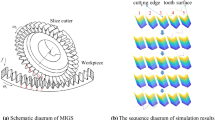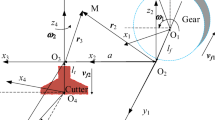Abstract
A calculation method for cutting force in gear slicing is proposed based on energy method. In view of the particularity of gear slicing, the cutting edge on a cutter tooth is divided into three sections: cut-in edge, top edge, and cut-out edge. Then, the concept of micro-section edge is proposed for the three curved edges. The cutting force on micro-section edge is calculated according to oblique cutting theory. The vector sum of cutting forces on micro-section edges make up the cutting force on one section of the cutting edge. Then, the cutting force on single cutter tooth is obtained by the vector sum of cutting forces on the three sections of the cutting edge. For the calculation of whole cutting force acting upon the cutter, the number of cutter teeth participating in cutting is determined based on coincidence degree. As a result, the whole cutting force is obtained by the vector sum of cutting forces on the cutter teeth participating in cutting. The feasibility of this cutting force calculation method is proved by a calculation example and the effectiveness of this method is verified by finite element simulation.
Similar content being viewed by others
References
Li J, Chen XC, Li XH (2010) Slicing method of cylindrical gears machining: China, 201010031366
Li J, Chen XC, Zhang HY (2011) Slicing technology for cylindrical gear. Chin J Mech Eng 47(19):193–198
Chen XC, Li J, He YP (2012) Structure design and calculation of spur slice cutter. J Tianjin Univ 45(5):411–416
Moufki A, Dudzinski D, Molinari A, Rausch M (2000) Thermoviscoplastic modelling of oblique cutting: forces and chip flow predictions. Int J Mech Sci 42(6):1205–1232
Li BL, Wang XL, Hu YJ, Li CG (2011) Analytical prediction of cutting forces in orthogonal cutting using unequal division shear-zone model. Int J Adv Manuf Technol 54(5–8):431–443
Astakhov VP, Osman MOM, Hayajneh MT (2001) Re-evaluation of the basic mechanics of orthogonal metal cutting: velocity diagram, virtual work equation and upper-bound theorem. Int J Mach Tool Manuf 41(3):393–418
Li LW, Li B, Ehmann KF, Li XC (2013) A thermo-mechanical model of dry orthogonal cutting and its experimental validation through embedded micro-scale thin film thermocouple arrays in PCBN tooling. Int J Mach Tool Manuf 70:70–87
Wan M, Zhang WH (2006) Calculations of chip thickness and cutting forces in flexible end milling. Int J Adv Manuf Technol 29(7–8):637–647
Lee TS, Lin YJ (2000) A 3D predictive cutting-force model for end milling of parts having sculptured surfaces. Int J Adv Manuf Technol 16(11):773–783
Li ZQ, Liu Q, Ming XZ, Wang X, Dong YF (2014) Cutting force prediction and analytical solution of regenerative chatter stability for helical milling operation. Int J Adv Manuf Technol 73(1–4):433–442
Wang B, Liu ZQ, Yang QB (2013) Investigations of yield stress, fracture toughness, and energy distribution in high speed orthogonal cutting. Int J Mach Tool Manuf 73:1–8
Fang N (1998) An improved model for oblique cutting and its application to chip-control research. J Mater Process Technol 79(1–3):79–85
Lin ZC, Lin YY (1999) A study of an oblique cutting model. J Mater Process Technol 86(1–3):119–130
Akyildiz HK (2013) Evaluating of cutting forces in thread machining. Int J Adv Manuf Technol 68(5–8):1601–1612
Chen XC, Li J, Lou BC (2013) A study on the design of error-free spur slice cutter. Int J Adv Manuf Technol 68(1–4):727–738
Chen XC, Li J, Lou BC, Shi J, Yang QJ (2013) Effect of the cutter parameters and machining parameters on the interference in gear slicing. Chin J Mech Eng 26(6):1118–1126
Kim DM, Bajpai V, Kim BH, Park HW (2015) Finite element modeling of hard turning process via a micro-textured tool. Int J Adv Manuf Technol 78(9–12):1393–1405
Li R, Shih AJ (2006) Finite element modeling of 3D turning of titanium. Int J Adv Manuf Technol 29(3–4):253–261
Tang LH, Huang JL, Xie LM (2011) Finite element modeling and simulation in dry hard orthogonal cutting AISI D2 tool steel with CBN cutting tool. Int J Adv Manuf Technol 53(9–12):1167–1181
Ucun I, Aslantas K (2011) Numerical simulation of orthogonal machining process using multilayer and single-layer coated tools. Int J Adv Manuf Technol 54(9–12):899–910
Author information
Authors and Affiliations
Corresponding author
Rights and permissions
About this article
Cite this article
Li, J., Wang, P., Jin, YQ. et al. Cutting force calculation for gear slicing with energy method. Int J Adv Manuf Technol 83, 887–896 (2016). https://doi.org/10.1007/s00170-015-7630-0
Received:
Accepted:
Published:
Issue Date:
DOI: https://doi.org/10.1007/s00170-015-7630-0




